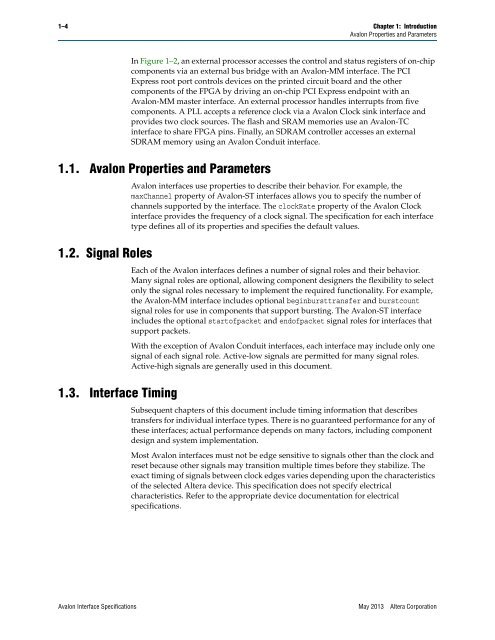Avalon Interface Specifications (PDF) - Altera
Avalon Interface Specifications (PDF) - Altera
Avalon Interface Specifications (PDF) - Altera
Create successful ePaper yourself
Turn your PDF publications into a flip-book with our unique Google optimized e-Paper software.
1–4 Chapter 1: Introduction<br />
<strong>Avalon</strong> Properties and Parameters<br />
In Figure 1–2, an external processor accesses the control and status registers of on-chip<br />
components via an external bus bridge with an <strong>Avalon</strong>-MM interface. The PCI<br />
Express root port controls devices on the printed circuit board and the other<br />
components of the FPGA by driving an on-chip PCI Express endpoint with an<br />
<strong>Avalon</strong>-MM master interface. An external processor handles interrupts from five<br />
components. A PLL accepts a reference clock via a <strong>Avalon</strong> Clock sink interface and<br />
provides two clock sources. The flash and SRAM memories use an <strong>Avalon</strong>-TC<br />
interface to share FPGA pins. Finally, an SDRAM controller accesses an external<br />
SDRAM memory using an <strong>Avalon</strong> Conduit interface.<br />
1.1. <strong>Avalon</strong> Properties and Parameters<br />
1.2. Signal Roles<br />
1.3. <strong>Interface</strong> Timing<br />
<strong>Avalon</strong> interfaces use properties to describe their behavior. For example, the<br />
maxChannel property of <strong>Avalon</strong>-ST interfaces allows you to specify the number of<br />
channels supported by the interface. The clockRate property of the <strong>Avalon</strong> Clock<br />
interface provides the frequency of a clock signal. The specification for each interface<br />
type defines all of its properties and specifies the default values.<br />
Each of the <strong>Avalon</strong> interfaces defines a number of signal roles and their behavior.<br />
Many signal roles are optional, allowing component designers the flexibility to select<br />
only the signal roles necessary to implement the required functionality. For example,<br />
the <strong>Avalon</strong>-MM interface includes optional beginbursttransfer and burstcount<br />
signal roles for use in components that support bursting. The <strong>Avalon</strong>-ST interface<br />
includes the optional startofpacket and endofpacket signal roles for interfaces that<br />
support packets.<br />
With the exception of <strong>Avalon</strong> Conduit interfaces, each interface may include only one<br />
signal of each signal role. Active-low signals are permitted for many signal roles.<br />
Active-high signals are generally used in this document.<br />
Subsequent chapters of this document include timing information that describes<br />
transfers for individual interface types. There is no guaranteed performance for any of<br />
these interfaces; actual performance depends on many factors, including component<br />
design and system implementation.<br />
Most <strong>Avalon</strong> interfaces must not be edge sensitive to signals other than the clock and<br />
reset because other signals may transition multiple times before they stabilize. The<br />
exact timing of signals between clock edges varies depending upon the characteristics<br />
of the selected <strong>Altera</strong> device. This specification does not specify electrical<br />
characteristics. Refer to the appropriate device documentation for electrical<br />
specifications.<br />
<strong>Avalon</strong> <strong>Interface</strong> <strong>Specifications</strong> May 2013 <strong>Altera</strong> Corporation
















